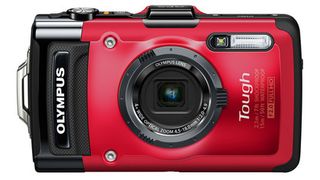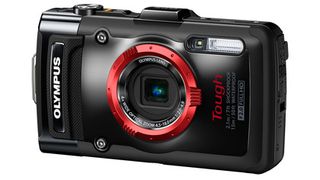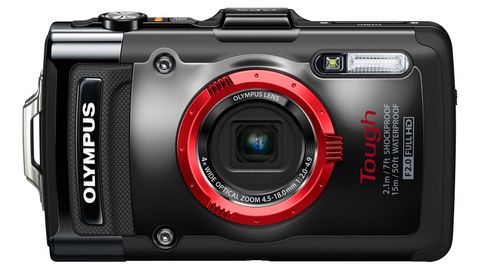TechRadar Verdict
Pros
- +
Controls exposure well
- +
Images have great colour
- +
Tough
Cons
- -
Smudges some finer details
- -
Screen glare is difficult
- -
Can't use controls wearing gloves
Why you can trust TechRadar
The new Olympus TG-2, which replaces the Olympus TG-1, has all the usual tough credentials. It's waterproof down to 15m (49ft), shockproof for drops from up to 2m (6.6ft), freezeproof down to -10C (14F) and crushproof to 100kg (22lbs).
The only one of these features to be enhanced above the Olympus TG-1's spec is the waterproofing, since the Olympus TG-2 can be used 3m deeper underwater than the Olympus TG-1 could.
Like the Olympus TG-1, the Olympus TG-2 has a 1/2.3-inch CMOS sensor with 12 million effective pixels, a sensitivity range of ISO 100-6400, a 3-inch 610,000-dot OLED screen and a 4x zoom lens with a focal length equivalent of 25-100mm.

As with the Olympus TG-1, one of the most exciting aspects of the Olympus TG-2's lens is that it has an aperture range of f/2-4.9. This means that at the shortest focal length a wide aperture is available, which enables you to use fast shutter speeds when light levels fall.
However, in an improvement over the Olympus TG-1, the Olympus TG-2 has aperture priority mode available, which means that as the photographer, you can actually chose which aperture to use if you want. As you might expect with a compact camera, the choice of aperture settings is rather limited, with just three being available at any given focal length.
Nevertheless, this aperture control gives the Olympus TG-2 extra appeal to enthusiast photographers who want to be able to blur backgrounds occasionally. Less experienced photographers, however, will be pleased to learn that there are a collection of fully automated scene modes on hand, along with Intelligent Auto (iA) mode.

There's also a Microscope Mode that effectively boosts the zoom to 200mm (35mm equivalent) and enables you to shoot from as close as 1cm.
Modern extras include GPS technology and an electronic compass built-in to record where you take your pictures, along with FlashAir card compatibility to enable wireless sharing of images on social media via your smartphone.
It's also possible to shoot Full HD movies with stereo sound and record video at up to 240fps (frames per second) for slow motion playback.
Build and handling

Olympus clearly looked after the mould for the Olympus TG-1, since it appears to have been used for the Olympus TG-2 as well. As before the camera feel nice and solid, with a reasonable weight to it.
Dual locked covers protect the battery and memory card ports, as well as the cable connections. Although these are a bit fiddly to operate they at least mean that you, or the smaller members of the family, are unlikely to accidentally open any of the doors when the camera is wet or covered in mud.
While the controls are reasonably sized for use in 'normal' conditions, they are rather fiddly to use when wearing gloves. As a result, if you are skiing it's likely that you will have to get a cold hand to press the buttons, and if you're in a wetsuit then you may get quite frustrated trying to make settings changes.

Olympus has again incorporated its Tap Control mechanism that enables settings to be adjusted and images taken using taps on the top, bottom, sides and back of the camera. We found using it a rather frustrating experience with mixed success.
Because the Olympus TG-2 doesn't have a viewfinder, images must be composed using the 3-inch screen on the back of the camera. Unfortunately, this makes composition almost guesswork in very bright conditions such as a ski slope or on a sunlit beach - just when you want to use a tough camera.
In more standard conditions, it is possible to see the scene and compose images more easily, but the settings options on the right of the screen can be hard to read outdoors.

The Olympus TG-2 is compatible with Olympus's Fisheye and Teleconverter lenses. Fitting either of these converters involves removing a ring around the lens. We found this trim quite prone to accidental removal when the camera is in a bag or pocket.
Performance
As we would expect from an Olympus camera, the Olympus TG-2 produces images with nice, natural colours that have a bit of punch but not too much contrast.
On the whole, images are also well exposed when the camera is left to its own devices or the appropriate Scene modes are selected.

The focusing is also good, although it's not possible to select an AF point away from the centre of the frame. When Face Recognition is activated, the camera quickly latches onto and focuses on a face.
Our tests reveal that the Olympus TG-2 produces good quality images in a range of conditions. However, at the risk of nit-picking, close inspection reveals that some details in out of focus areas are a little smudged, even in images taken at the lowest sensitivity settings.
In some cases this loss of detail is apparent when images are sized to make A4 (US letter size) prints - if you know what you're looking for.

We suspect that the vast majority of Olympus TG-2 users will be more than happy with the image quality that the camera turns out, but because it has an aperture priority mode it may find itself in the hands of photographers who are more used to scrutinising shots from DSLRs.
The results of our labs tests for noise and dynamic range, image quality and resolution, and sensitivity are all on the following pages, along with sample images from the Olympus TG-2.
Comparing our resolution chart images from the Olympus TG-2 with those from other rugged cameras such as the Panasonic FT4 and Nikon AW100 also reveals that it can't resolve quite as much detail.

This is interesting, because it conflicts a little with our signal to noise ratio results that show the Olympus camera is a good performer by comparison. It suggests that Olympus has masked image noise more than the other cameras and the in-camera processing manages to maintain a high image signal.
Verdict
In many respects the Olympus TG-2 is a good performer. It produces sharp, well-exposed images with excellent colours in a range of situations.
It also enables you to take images in situations that just a few years ago were out of bounds for most photographers.
However, the Olympus TG-2 may not be the camera to buy if you are looking to make lots of large prints, since some fine details look smudged.
We liked
The Olympus TG-2 offers good control over exposure for a tough camera and it produces images with great colour and plenty of impact.
We disliked
The loss of detail in out of focus areas limits the size at which images can be viewed or printed.
As with other GPS-enabled cameras, using the GPS technology reduces battery life considerably, so most users are likely to turn it off.
However, the main issue that we have with the Olympus TG-2 is that the screen is hard to see in the very conditions that you are most likely to want to use a rugged camera - on the beach or in snow.
Final verdict
The Olympus TG-2 is pretty good example of a tough camera, but like several others, the controls are a bit too fiddly for use with gloved hands. The screen also suffers from reflections in very bright light, which is a problem if you want to use it on skiing or beach holidays.
Its image quality is good, provided you don't scrutinise out of focus areas too closely.

